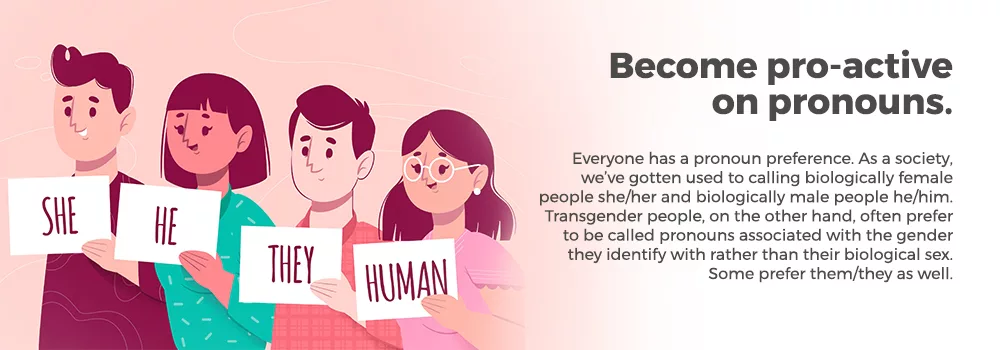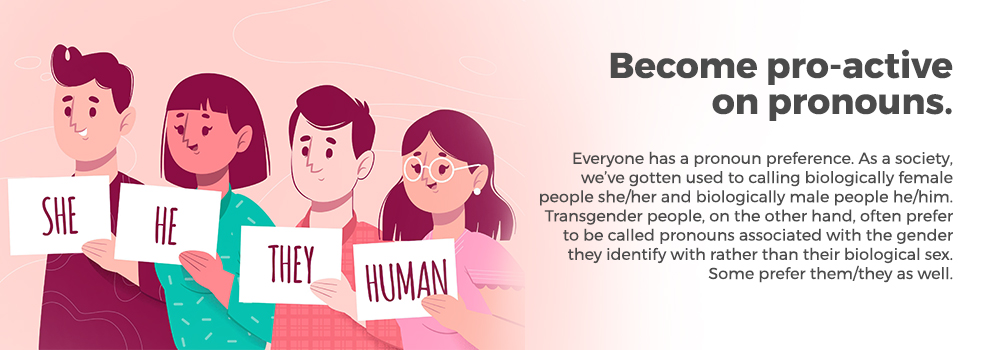Does the topic of gender identity seem too personal or difficult to address within your business? Or maybe you feel that it’s not a problem in your workplace because you’re not aware of any employees that may have an issue with gender identity.
But what is gender identity? Let’s look at exactly what it means before we continue.
Gender identity is a person’s internal sense of being female, male, or something other or in-between, regardless of the sex they were assigned at birth. It’s not connected to one’s biological sex or sexual orientation.
ACAS (Advisory, Conciliation, and Arbitration Service) prepared this identity guide for a more comprehensive description of gender identity terms.
Equality and inclusivity are high priorities in today’s workplace because employers want to ensure their workers are happy and comfortable to be more productive.
Sadly, we have to understand that discrimination is real against transgender employees in the workplace. According to a survey conducted by Totaljobs, 60% of transgender employees have experienced workplace discrimination, and 53% felt they had to hide their trans status from colleagues.
The Human Rights Campaign Foundation’s Workplace Equality program conducted the following three national studies of the workplace environment for LGBTQ (lesbian, gay, bisexual, transgender, and queer) workers:
- Degrees of Equality.
- The Cost of the Closet and the Rewards of Inclusion.
- A Workplace Divided: Understanding the Climate for LGBTQ Workers Nationwide.
In the first two studies, more than 50% of LGBTQ workers nationwide felt compelled to remain in the closet in the workplace. The third study looks to uncover the prevalence of LGBTQ workers feeling pressure to hide their sexual gender or identity in the workplace and the consequences of hiding it from employers and co-workers.
Thanks to the dedicated work of LGBTQ advocates and trailblazers like Stonewall, employers have grown increasingly aware of the importance of creating welcoming workplaces for LGBTQ employees.
As an employer, one of the most important things you can do to handle gender identity successfully in your organization is to approach it with professionalism and kindness.
Here are some actions you can take to create a more welcoming and equitable work environment for trans and gender-nonconforming employees:
-
Become pro-active on pronouns.
Everyone has a pronoun preference. As a society, we’ve gotten used to calling biologically female people she/her and biologically male people he/him. Transgender people, on the other hand, often prefer to be called pronouns associated with the gender they identify with rather than their biological sex. Some prefer them/they as well.
We can’t assume someone’s gender pronouns just by appearance. Supporting and understanding transgender and gender-nonconforming people means using and respecting their correct gender pronouns.
Create a culture where everyone feels comfortable introducing themselves with pronouns. For example, “Hi, I’m Jenny, and my pronouns are they, them, and theirs.” Many businesses are taking a proactive step by including gender pronouns in their email signatures or wearing pins.
-
Deploy sensitivity training proactively – don’t wait for an incident.
Train your employees on handling trans issues and encourage them to conceptualize someone else’s experience as their own. When asking for clarification on a trans person’s gender identity, ask employees to be respectful, self-aware, and discreet.
Some employees in the workplace may be resistant to accommodations for transgender individuals in the workplace. They may unintentionally discriminate against their trans-co-workers, making them feel uncomfortable or judged with their identity.
This behavior must be addressed, and training should be provided, hoping that they will become more considerate towards their trans colleagues. They should also be aware of the consequences as the Equal Employment Opportunity Commission offers extended protections that include all LGBTQ workers.
-
Do you have a trans-friendly dress code?
According to a Forbes article by Mirande Valbrun, the Human Rights Campaign noted, “Employers can legally implement gender-specific dress codes as long as they are not arbitrarily enforced and do not favor nor affect one gender over another.”
If you have a dress code, it should be modified to avoid gender stereotypes like requiring men to wear suits and women to wear skirts. However, employers have a right to establish employee dress and grooming guidelines during work hours if they are reasonable and serve a legitimate business purpose. These purposes could include safety (wearing goggles or gloves) and visibility (law enforcement or medical staff).
-
Create a plan for bathrooms.
All employees, including transgender and gender-nonconforming employees, should have access to restrooms that correspond to their gender identity.
Trans employees should feel safe knowing they are welcome to use the restroom in the space they define, whether it’s male, female, or gender-neutral. If possible, employers can make gender-neutral bathrooms available to transgender and non-gender-conforming employees. These gender-neutral facilities can be added to the standard male/female bathrooms, or the gender-specific restrooms can be removed altogether so that all bathroom spaces are gender-neutral.
-
Make sure your team knows that HR’s door is always open.
Transgender employees will frequently “come out” to their direct manager or human resources representative, hoping to discuss the practicalities of their transition, legal rights, and what the existing corporate policies are.
To manage transgender issues in the workplace effectively, HR and management should ensure all employees receive clear guidelines for appropriate and respectful workplace behavior toward their trans-co-workers. Everyone should know your HR staff is open to discussing these matters confidentially and willing to help solve any issues that might occur.
-
Build a culture of empathy and one that embraces diversity.
Fostering a workplace that’s equitable and inclusive for everyone requires one key trait that all great leaders should possess: empathy. Empathy is our ability to put ourselves in the shoes of others to understand what they’re experiencing. Emphatic leaders may be more effective at fostering diverse and inclusive workplaces.
Building a culture of empathy and diversity holds many benefits. Employing individuals from all backgrounds, genders, races, and religions raises creativity and productivity in the workforce. Reduced fear among your employees will lead to improved performance, boosting your brand’s reputation.
Conclusion
Creating a truly inclusive workplace takes a sincere commitment to change your company culture. It requires understanding the everyday experiences of all the individuals in your organization and making the necessary changes for everyone to be their best. When you make your organization more trans-inclusive, you will make it more attractive to current and prospective employees and, ultimately, more productive.
Coggno has a wide range of online training courses relating to gender identity.
You can have a look at our free courses here and our course catalog here.



















